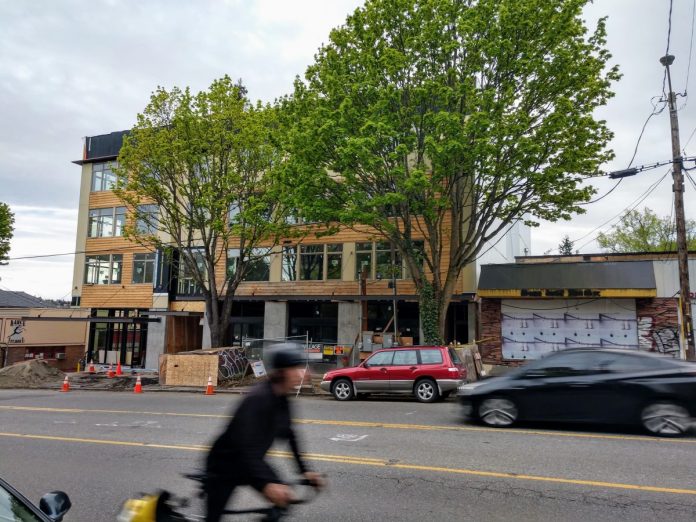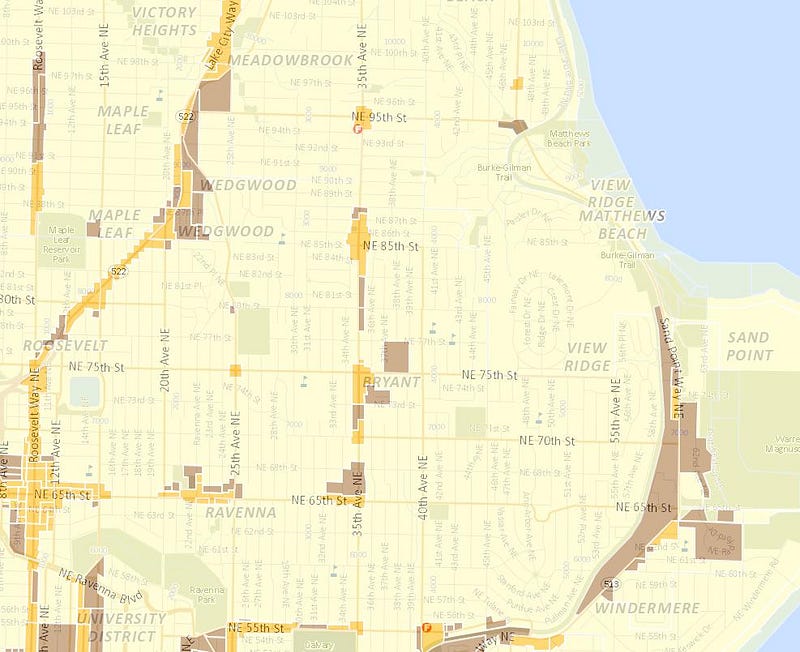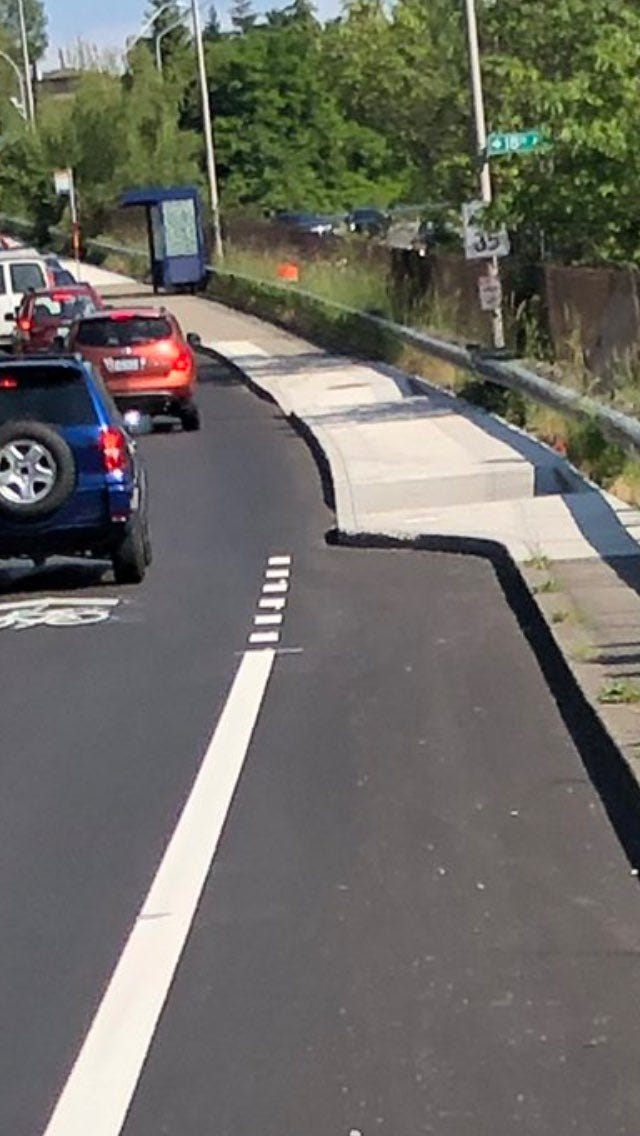
The last year in Seattle has been pathetic for safe streets, equitable mobility, and climate action. Mayor Durkan has been killing safe streets projects left and right—including 35th Avenue NE, with an associated bike lane. The bike lane was going to provide direct and safe access to schools, a neighborhood library, businesses, and homes. However, instead of prioritizing safe streets, the mayor decided climate arson, deadly 12-foot wide lanes motorists are using as speedways, and free car storage were more important. The Mayor and the Seattle Department of Transportation (SDOT) need to fix this. Protected bike lanes belong on arterials — yes, in Seattle — and probably in your city, too.
Seattle has grown rapidly — it grew by only 8.5% from 1994 (the year the urban village strategy was adopted), to 2005 (the year I moved to Seattle). Since 2005, the city has grown by over 30%. In less than 14 years, Seattle grew by nearly a third. At the same time, as Gene Balk noted in his piece, ‘Some Seattle Neighborhoods are untouched by rapid population growth. Why?’ — this tremendous growth has not been balanced. A fraction of the city has seen nearly all of the growth, the direct result of a misguided urban village strategy (that never had to be reviewed with the Race and Social Justice Initiative) that was largely co-opted by a small number of homeowners to keep apartments and affordable housing away.
At the same time, we have a zoning map today that has not evolved much from the ‘snapshot’ zoning map of 1923. Multifamily land in much of the city is limited to arterials — and this is a huge problem for equity, climate, and mobility. By limiting new development to arterials, we focus housing and businesses and mobility on the most congested, polluted, unsafe, and noisiest streets. This is antithetical to any notion of livability. Luckily, there are solutions, being adopted the world over, that work to reduce the pollution, noise, and danger of these arterials. Protecte bike lanes? They’re a major part of this solution.

Climate Change
We have less than 11 years to avoid the most catastrophic effects of climate change. People are fleeing Florida. In the time span of two months, Seattle had one of the mildest winters, followed by one of the coldest and snowiest spells in recent memory, followed by a record-setting heat wave — Seattle was 25 degrees above normal in the middle of March.
Our city’s climate goals are not being met — and the reason they aren’t being met is because of cars. Unfortunately, Mayor Durkan’s Climate Action Plan does virtually nothing to move the dial on this issue. And the city council’s actions to eliminate parking requirements in urban villages isn’t enough, though it is critical, to at least start to address this issue. The city must take a more active role to increase and incentivize green mobility — prioritizing transit, protected bike lanes, pedestrian zones, and deliveries by modes other than motorized vehicles.
Noise Pollution
Reducing the speed and volume of car and truck traveling on arterials will result in quieter streets for everyone. Cities in Europe track noise in urban environments — you can check out Amsterdam’s map here. London’s noise map is here. Seattle? Doesn’t track this information. Prioritizing green mobility and green logistics will reduce the amount of cars and trucks needed to move through a limited roadway without reducing throughput. Moreover, protected bike lanes that use planters for separation provide the added benefit of sound absorption–not to mention making streets more appealing places to be.
Just look at how quiet this street in Utrecht is during rush hour. This is what post-carbon cities will look and sound like.
Safety
Relegating cyclists to greenways off arterials will never result in the rapid uptake of cycling adoption we need to meet our climate goals. It prevents cyclists from getting to their destinations , which are very often on arterials because of our absurdly limiting zoning plan. Most greenways are lined with parking on both sides of the street, are not safe, and are not wide enough for a car and bike to pass each other. Add the unsignaled intersections at every block — and they can be incredibly dangerous — especially with impatient drivers. Where greenways are forced to cross arterials, all of these problems are amplified. I have lost all hope that SDOT cares about these issues.

Seattle’s roads have two classifications: Arterials and residential streets. Similar to the imbalance of open space and schools in urban village multifamily zoned areas versus single-family zones, there is also a disparity in safety. As of 2016, downtown arterials have a posted speed limit of 25 mph (previously, 30 mph), Residential Streets have a speed limit of 20 mph. However, this hasn’t been adopted citywide, so many of the arterials outside and between urban villages — the same ones where we limit multifamily housing too — in some cases still have higher speed limits. Map of the improved speed limits here.
Cost
The health benefits of biking are known and clear. What is the cost of congestion to businesses? Commuters? For years, we’ve had to listen to (incorrect) moaning about how expensive bike lanes are. The cost overruns on the Alaskan Way Viaduct Replacement tunnel alone will be more than the entire cost to build out the basic bike network. The Mercer Corridor was a massive waste that is hostile to anyone who isn’t in a car, I missed where anyone whining about the cost of bike lanes balked at this $260 million project. As a city, Seattle should be doing everything possible to make getting around without a car easier. Instead of taxing bikes, as was proposed in the most recent legislative session—we should be subsidizing their usage. Oslo offered subsidies that covered a significant portion of e-cargo bike purchases. Sweden has set aside millions of dollars per year to subsidize e-bikes. Berlin’s e-cargo bike subsidy program was tapped out in a single day. Just 2% of the Mercer corridor’s project costs would have provided a $1,000 subsidy to over 5,000 e-bikes.
A2Bism
‘ The homo sapiens of a city will always figure out the fastest A to B. We call it A2Bism. We are all like rivers, finding the easiest route. Make that the bicycle or public transport and you are halfway there’ — Copenhagenize
This is true in Seattle. This is especially true when everything people need to go to is on arterials. As long as Seattle continues to prioritize car storage over safety, as long as it fails to create expedient travel between destinations for modes that aren’t cars, as long as it fails to prioritize re-democratizing our roads from the singular thing that is preventing us from achieving our climate goals (CARS!), and yes — the very object that has been decimating livability and lives for decades — we are doomed.
The Mayor has talked ad nauseum about Vision Zero. The State of the City speeches wax poetic about building protected bike lanes — all the while instructing SDOT to kill and delay projects all over the city. Imagine if the Mayor actually walked the walk, and took a page from the playbook of any major city in the world (Barcelona, Paris, Oslo, hell even Vancouver), and instead of gaslighting advocates for safe streets and lying to the city about their cost or construction, actually took a lead on this issue. We would have a quieter, healthier, cleaner and more livable city. And frankly, our kids’ safety, let alone our own, depend on it.
This is a cross-post from Mike Eliason’s blog on Medium.
Mike is the founder of Larch Lab, an architecture and urbanism think and do tank focusing on prefabricated, decarbonized, climate-adaptive, low-energy urban buildings; sustainable mobility; livable ecodistricts. He is also a dad, writer, and researcher with a passion for passivhaus buildings, baugruppen, social housing, livable cities, and car-free streets. After living in Freiburg, Mike spent 15 years raising his family - nearly car-free, in Fremont. After a brief sojourn to study mass timber buildings in Bayern, he has returned to jumpstart a baugruppe movement and help build a more sustainable, equitable, and livable Seattle. Ohne autos.



